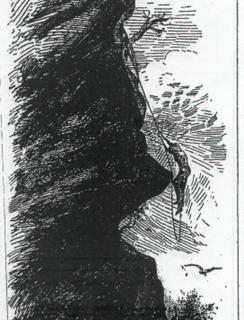 Epics on Mt Lindesay
Epics on Mt LindesayPerhaps the most interesting aspect of these early ascents of peaks in the southeast is that there had been a philosophical shift from exploration as the impetus for climbing to something else. But it was almost 20 years until the third ascent of Mt Lindesay—and the most dramatic. On a cold July morning in 1890, 26 year old immigrant Norwegian naturalist Carstens Egeberg Borchgrevink sweated up the approach ridge with climbing partner Edwin Villiers-Brown, from nearby Beaudesert, and a third man, had agreed to join him on what they believed would be the first ascent. They carried with them ‘a manilla clothes-line about 25ft long, a tomahawk, and our sandshoes’. Borchgrevink and Villiers-Brown climbed to the base of a short steep rock pitch with a 70 metre drop below them where Villiers-Brown, ‘being the lighter of the two’, took the lead. He was instantly in trouble when a huge loose block of rhyolite pulled away, as Borchgrevink recounted: ‘Only his great presence of mind saved him. Quicker than thought, while sliding down he caught his fingers in a narrow crack, and so supported himself till he got a new hold. Eventually he got over and let down a string.’They struggled onto the scrub-clothed summit in the late afternoon light, shook hands, and realised there were no views. With the light fading, they began their descent. With one end of the rope tied around his chest, Borchgrevink began lowering himself over an overhang when he felt ‘a strange weakness’ in his arms: ‘My fingers gave way, and I held on to the rope with my teeth; but with them I could not carry my weight, and I felt that I must drop,’ he recalled. ‘My hands would not move to my assistance. What could I do? I dropped straight down, thinking “this will be my goodbye to the world.” The line, however, tightened under my arms, a creeper caught one of my legs, and for the moment I was safe.’ Their exploits were captured by artist Bihan in local publication, the Queenslander (above). The plucky Norwegian survived his Mt Lindesay ordeal and in January 1895, became the first person to set foot on the Antarctic continent.
Illustration: The Queenslander.
No comments:
Post a Comment